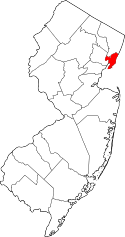Landmarks of Hoboken, New Jersey
Hoboken, New Jersey is home to many parks, historical landmarks, and other places of interest.
Landmarks
Assembly of Exempt Firemen Building
Carlo's Bakery
A famous bakery and setting for the TLC reality television series Cake Boss. It is located on Washington Street, across from City Hall.
Castle Point

Castle Point is the highest point in Hoboken. The name is a corruption of "Castille Point", due to its supposed resemblance to the Castilian coast in Spain. To early navigators, the high serpentine crag jutting over the river reminded them of a miniature Rock of Gibraltar (although the Rock of Gibraltar is actually in Andalusia, not Castile which has no coast). The land was bought at public auction in 1804 by Col. John Stevens, who built his estate there.[1] After his death, his son Edwin Augustus Stevens took responsibility of the estate and in 1853 built a 40-room mansion, the "Stevens Castle", on land adjacent to the point. It was acquired by Stevens Institute of Technology in 1910 and served as an administrative and residential building until 1959. Castle Point is still part of the Stevens campus. On the side of Castle Point is historic Sybil's Cave.
Castle Point also includes the surrounding area and streets such as the yellow brick Castle Point Terrace. Castle Point Park and Castle Point Skate Park are at the base of Castle Point, next to the Hudson River.
Clam Broth House
The Clam Broth House (1899–2004), was a landmark Hoboken restaurant that operated for over a century.
The Clam Broth House opened in 1899. The restaurant attracted attention with several giant hand-shaped signs. There were two giant hand-shaped signs, one hanging on the outside of the Clam Broth House that pointed downward towards the entrance, and one on a neighboring building (which is the only sign still there today). In addition, there was a third, smaller hand-shaped sign.
In 2004, the Clam Broth House building was condemned by city officials because of structural failures caused by construction workers, and destroyed. There were cracks and bulges in the building's facade prior to the building's destruction, and the facade also buckled in May 2003, causing it to be shut down.
The Clam Broth House reopened in 2010, but was bought in 2012 by another restaurant, Biggie's Clam Bar. [2] [3]
DeBaun Auditorium
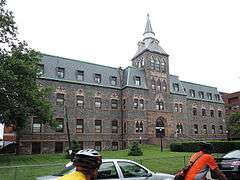
In Edwin A. Stevens Hall on 5th Street opposite Stevens Park.[4]
Hoboken City Hall
Hoboken Free Public Library
At Church Square Park, the library contains a collection of historical photos and publications related to the history and culture of Hoboken. Erected with funds from philanthropist Martha Bayard Stevens in 1896. [5]
Hoboken Historical Museum
The Hoboken Historical Museum was founded in 1986 and moved into its current location at 1301 Hudson St. in 2001. It presents displays on the city's history as well as exhibits of local artists' work. Its current location was once the W. & A. Fletcher Company machine shop, a hub of the city's 19th century shipbuilding and repair industry.[6]
Hoboken Projects
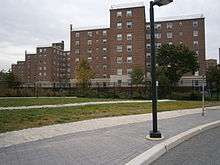
The Hoboken Projects are a complex of low-income apartments on the western side of Hoboken, built in the 1960s. Though the Hudson-Bergen Light Rail has created a station near the Projects to connect it with other parts of Hudson County, residents are prevented direct access from the projects and must walk one block south and then again one block north to gain access.
Hoboken Terminal
Hoboken Terminal, at the city's southeast corner, is a major transportation hub and a national historic landmark was built in 1908.
Hudson River Waterfront Walkway
The Hudson River Waterfront Walkway is a promenade along the Hudson River.
Hudson Tea Building
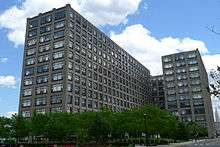
The Hudson Tea Building apartment complex (1500 Washington and 1500 Hudson Streets) was the former site of a major Lipton Tea plant. The part of the Hudson River Waterfront Walkway which opened in 2004 forms a "C" shape around the west, north and east sides of buildings at the Hudson Weehawken Cove Although places are farther north and east than the northeasternmost point in Hoboken is found here. It is the home of former New Jersey Governor Jon Corzine, New York Giants quarterback Eli Manning and was used as a residence by actress Mischa Barton when she filmed the 2009 film Assassination of a High School President in nearby Bayonne.[7]
Miracle statue
On July 29, 2005, a claim was made that a miniature statue of Jesus opened one of its eyes on its own. Before July 29, its eyes were shut. The statue is a part of a shrine at the corner of Jackson Street and Third Street that is taken care of by Julio Dones, a partially blind man who says he noticed one of its eyes was open while he was cleaning it. He claims that it is a miracle, while others believe it was a hoax. Some believe that there were already eyes in the statue, and that eyelids were glued on and one of them fell off. Regardless of how it happened, the incident gained publicity quickly. On July 29, 2005 two local news stations, ABC and UPN, came to the shrine to report it live and interview people. It has since been called "The Miracle Statue".[8] The statue was found in a Jersey City garbage bin in 2004.
Maxwell's
In the early 1980s after his family bought the uptown Hoboken building, Steve Fallon began booking bands into what had been the ground floor tavern's back dining room. Bands like R.E.M., Sonic Youth, Bruce Springsteen and the E Street Band, My Chemical Romance, Fugazi, They Might Be Giants and Nirvana have all played Maxwell's. Except for a small break in the 1990s, Maxwell's has been a vital a part of the indie music community ever since.
Marineview Plaza
Marineview Plaza is a building complex made up of two 25-story buildings, built in Brutalist style. The Marineview buildings are the tallest buildings in Hoboken, New Jersey. Marineview Plaza One is the northernmost and Marineview Plaza Two is the southernmost. Both buildings are residential, and are bordered on the west by Hudson Street, on the north by 4th Street, on the east by River Street and on the south by 3rd Street. In 2001 many floors' views of the New York skyline were blocked by the 333 River Street complex. Even so, they are still visible from Manhattan.8 9
As well as having two 25-story buildings, the Marineview Plaza complex also has three smaller buildings, one of which (Marineview Plaza five) once housed Hoboken's only movie theater, which has since closed and been replaced by a bank.
Stevens Institute of Technology
The university is situated overlooking the Hudson.

Sybil's Cave

Sybil's Cave is a cave with a natural water spring, that is now buried at the bottom of the Stevens Institute of Technology hill, near the Castle Point Skate Park on Frank Sinatra Drive. One of Hoboken's best known landmarks, it was first excavated around 1832 by Hoboken's founder, Col. John Stevens III, and adorned with a gothic-style stone arch. Named after the ancient Greco-Roman prophetesses, it was originally Hoboken's biggest tourist attraction, for the magnesium-laced water that flows from the spring.[9]
The cave gained national attention in 1841 when the body of a young cigar shop worker, Mary Cecilia Rogers, washed ashore nearby, an incident that inspired Edgar Allan Poe's The Mystery of Marie Rogêt, one of the first true-crime detective novels. From the mid- to late-1800s, thousands of glasses were sold daily for a penny each to tourists from New York, who drank the cave's water[10] in the belief that it had therapeutic properties.[11] The cave was closed in 1880 due to health department concerns about water quality, and it was used as a cool storage locker for a nearby eating establishment. That establishment devolved into a seedy waterfront tavern and closed in the 1930s, when the cave was filled in with concrete and dirt.[9]
Around the time of World War I the cave fell into disuse and was sealed. It was reopened in October 2008 after former Mayor David Roberts worked with the Hoboken Historical Museum, Hoboken Brownstone company and others on a $106,752 renovation project to unblock the cave and make it accessible to the public.[11]
Today, although the exterior gate to the park is usually open 24 hours a day, the gate to the cave itself is locked, as its water was found to contain too many impurities to be drinkable, and the interior is rocky and slippery. As of June 2014, there are no plans to reopen it.[9]
Weehawken Cove

Weehawken Cove is a small cove that extends westward from the Hudson River. The cove straddles the boundary between Hoboken to the south and Weehawken to the north. Explorer Henry Hudson anchored his ship there on October 2, 1609. His first mate noted that Castle Point looked as if it contained silver mines.
United Synagogue of Hoboken
Listed on the National Register of Historic Places, the United Synagogue of Hoboken is among the oldest synagogue buildings in New Jersey.
Parks
Castle Point Park
Castle Point Park is a public park consisting of a walkway along the Hudson River, offering scenic views of Manhattan. Stretching north along the river from Frank Sinatra Park, it terminates near 10th Street, with Sinatra Drive following along its length. Castle Point Park runs past the bottom of Castle Point, home to the Stevens Institute of Technology. Historic Sybil's Cave is also visible from the park.
Within the park is the Castle Point Skate Park, Hoboken's only designated skateboarding area. It features many ramps: one small half-pipe, one large half-pipe, one quarter pipe, and one 45° ramp, as well as several smaller ramps.
Church Square Park
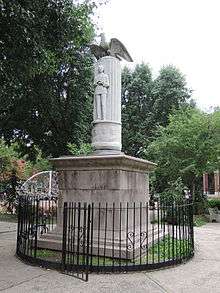


Renovation began in 2012 for Church Square Park after much community input as part of a City wide park improvement plan. New play equipment. A parents group is replacing out date equipment and soft surfacing added, fully up dated bathrooms, the basketball courts are being resurfaced, fenced and lighted. The dog park run is being resurfaced and re-fenced.
Church Square Park is bordered on the west by Willow Avenue, the east by Garden Street, the north by 5th Street and the south by 4th Street. Park Avenue is blocked by the park. Church Square park is surrounded by landmarks, such as the OLG church, the Hoboken Public Library on the north side, the Demarest School Building on the east, and nearby Hoboken University Medical Center.
In the eastern part of the park is a statue of the radio pioneer Guglielmo Marconi, with a bas-relief tribute to the Four Chaplains. The statue, commissioned and donated by John Minervini, replaced the Italian 1939 World’s Fair Marconi statue, damaged in transit, which Mr. Minervini received from the Italian government.
The Firemen's Monument, Hoboken is a statue of a fireman, in the western part of the park.
There is a gazebo in the center of the park, it used to be a fountain, where weekly outdoor concerts are held in the summer and fall. The playground and swings are slightly southeast of the gazebo, and there are also 4 fields (formerly 6), a dog run, and many bushes. "No ball playing" signs have been put up in the fields.
In 1994, the wooden playground that had been in place for a long time was destroyed and replaced with a safer playground.
In 2005, a memorial grove, containing trees dedicated to a fire victim, was relocated to a less attractive part of the park to make way for a toddler playground, despite public opposition. Questions were raised about the toddler playground's necessity, and those opposed to the project argued that there was no need for it since there were already 3 playgrounds within Church Square Park. They also argued that the new toddler playground was an eyesore and had replaced too much open space (at the time, 6 major fields were reduced to 5). In March 2005, the oldest tree in Church Square Park was removed to make way for playground. Despite controversy, it was finished in April, 2005.
Columbus Park
Columbus Park is a park near Hoboken High School at the corner of 9th Street and Clinton Street originally designed by Charles N. Lowrie, who was landscape architect for the Hudson County Parks Department. There is a statue of Christopher Columbus in the center of the park. There is also a memorial dedicated to John A. Sacci, a Hoboken High School teacher, who was shot in 1997. To this day, the word "remembrance" is misspelled on the marble monument.
There was once a one-of-a-kind playground, tall as a three story building with unusual equipment. It was destroyed in October 2002 to make way for a more normal, packaged (and safer) playground, in the name of Deborah Lynn Williams, a woman who was killed in the World Trade Center in the September 11 Terrorist Attacks. Because of the new playground's memorial status, the original playground will probably never be re-built. The original playground was made up of 3 sections: the first section contained a complex of chains for climbing, 3 platforms, and a very tall slide made of plastic (probably the tallest in Hoboken), which curved and could be seen over 6 blocks away. The second section was a large castle-like structure with a slide, two entrances and a pole for sliding. The third section was a series of unusual and unique space-like metal domes, which kids could crawl through and create echos. There was also a fourth section including a fountain where children would play. All of this equipment was disrespectfully trashed and thrown out in 2002. The new playground has only one section, and is considered by most to be unoriginal compared to the first playground. No photos are known to exist of the original playground.
Hoboken Island
Hoboken Island is a planned park7 in Hoboken, New Jersey, connected by a bridge to Pier A's gazebo, honoring the September 11, 2001 victims. The park was among many designs submitted to create a Hoboken 9/11 memorial. The "Hoboken Island" concept by the FLOW group was chosen in September 2004. When the park is constructed, a beam of light is planned to be in the center. There are 57 victims recognized in the project. Currently, there is a temporary memorial already on Pier A, in the form of a tear drop.
Frank Sinatra Park

Frank Sinatra Park is a park near Pier A, offering views of Manhattan. Built in 1998, it honors Frank Sinatra, who was born in Hoboken. Sinatra Park is shaped in a Roman amphitheater style with an area that faces the former site of the World Trade Center. The Hoboken Division of Cultural Affairs regularly produces events at the park such as their Thursday concerts featuring a variety of New Jersey-based and regional musical acts and "Shakespeare Mondays" present by the Hudson Shakespeare Company. Other attractions include a soccer field.[12]
On August 24, 2004, CNN broadcast live episodes of Inside Politics and Crossfire from the park.
Gateway Park
Gateway Park is an official yet secluded park that was created in 2000 to help make the neighborhood more scenic. In 2002 Troop 146 cleaned up Gateway Park for Earth Day and also cleaned up nearby Jackson Street. The park itself has trees, grass, and a bird feeder. There is an official sign at the park that says "Your Park", although it does not say "Gateway Park" yet. The park, triangle-shaped and about the size of a gas station, is Hoboken's smallest park.
Gateway Park is on the southwest corner of Hoboken, bordered to the south by the train tracks that separate Hoboken from Jersey City. To the east is an abandoned building (the Windsor Wax Company). The park also borders Newark Street and is at the intersection of Newark Street and Jackson Street. On two of the three sides the park is lined with pine trees.
Jackson Street Park
Jackson Street Park is a park on Jackson Street near 1st Street.
Jackson Street Park is a young children's play park built within the shell of a historic building surrounded on three sides by buildings and open to the sky.
It was fully renovated in the mid-2012 with new play equipment, soft surfacing. a water spray for summer use and a rock climbing wall.[13]
Madison Park
Madison Park (also called Madison Street Park) is at the corner of 3rd Street and Madison Street. There's a large abstract painting on the building that faces it. The original playground since the park's founding in 1991 contained a metal slide and a community trellis. The slide and trellis were destroyed in December 2006 to make way for park "renovation". The original playground is still visible on Google Earth.
Madison Park was renovated and soft surfaced it has play equipment for children of different age groups and a water park area for summer use.
Pier A
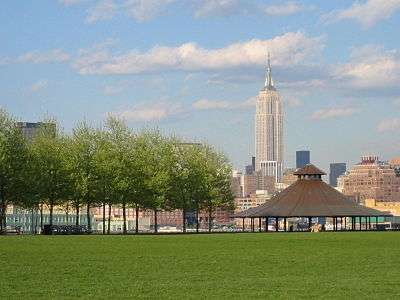
Pier A was originally used as a pier for ships and was recrafted as a park in 1999. It extends from the southern end of Hoboken (just north of the Hoboken Terminal) east into the Hudson River, with a view of the entire Manhattan skyline. At this point, the Hudson River starts to be affected by the tides in New York Bay. Pier A has a water-jet fountain, bike paths, rows of trees (some of them transplanted in maturity), a big field, a fishing area (with water pumps and cutting boards) and a gazebo at its eastern extremity. It is an example of good civic design, particularly the grass field which is firm and natural-looking though its sod is layered atop concrete.
Since Pier A is the nearest park to downtown Hoboken, at lunchtime on weekdays, many office workers take the time to stroll on the pier. On hot, summer weekends, the grassy field is swarming with sun worshippers. In warm weather, movies are shown on the pier at night, the blazing Manhattan skyline rising behind the screen. On one Saturday during the summer, a town fair is held on Pier A, including music, craft shops and rides for the kids. Hoboken also has its Fourth of July celebrations on Pier A.
Many people witnessed the September 11, 2001 Attacks from Pier A because it had good views of the World Trade Center. On March 11, 2002 a memorial service was held on Pier A. On September 11, 2003 a section of land was created as a memorial for the September 11, 2001 victims (by planting trees). Currently, there is a temporary memorial to victims in the form of a tear drop. A permanent memorial, called Hoboken Island, is planned to be built.
Stevens Park
Stevens Park is bordered on the west by St. Peter & Paul Church, on the south by the Marineview Plaza complex, on the east by the Hoboken Little League Field, and on the North by buildings of the Stevens Institute of Technology.
Within Stevens Park is a large playground and one of the few unique playgrounds left in Hoboken. Other one-of-a-kind playgrounds that have since been destroyed include the very tall playground in Columbus Park, destroyed in 2002, and the wooden playground in Church Square Park, destroyed in 1994.
There is also a very rare exposed section of serpentine rock in the southern portion of the park, which has been eroded away over the years by people stepping on it. In the central section of the park is a dog run, which is smaller than the one in Church Square Park, and as a result, the park area surrounding the dog run is cleaner. Also, in the western part of the park are two Dahlgren guns (from the USS Portsmouth) facing west towards the St. Peter & Paul Church's cafeteria. A scientist found ancient writings on a stone when he was studying the park.
Elysian Park
Elysian Park is a small park in Hoboken, New Jersey that is the last remnant of the Elysian Fields. Bounded on the west by Hudson Street, and the north and east by Sinatra Drive, Elysian Park has two play areas, a basketball court, a sprinkler, a dog run and rest rooms. The northern end of prestigious Castle Point Terrace ends at the park. Part of the 1954 film On The Waterfront was filmed there.[14]
See also
References
- ↑ "Hoboken, Castle Point", Historic Houses of New Jersey (1902).
- ↑ "Biggies Clam Bar". hoboken411.com. 12 March 2012. Retrieved 19 September 2015.
- ↑ "Biggies Clam Bar History". biggiesclambar.com. Retrieved 19 September 2015.
- ↑ DeBaun Center for Performing Arts. Stevens Institute of Technology. Accessed November 19, 2008.
- ↑ Stevens Matriarch, by Leah Loscutoff, Archives and Special Collections Librarian
- ↑ Hoboken Historical Museum. "Hoboken Historical Museum—Points of Interest". Hoboken Historical Museum. Retrieved December 11, 2014.
- ↑ Sullivan, Al (September 23, 2007). "Movie stars seen around Hudson County" The Union City Reporter. p. 8
- ↑ Nickell, Joe (August 9, 2005). "Statue Mystery Solved". Committee for Skeptical Inquiry.
- 1 2 3 Abernathy, Melissa (Summer 2014). "What the Heck is Going on with Sybil's Cave?". Hoboken 07030. pp. 24-37. Retrieved June 29, 2014.
- ↑ Launay, Michael. "The Legend of Sybil's Cave and the Murder of Mary Rogers". hobokeni.com. Retrieved June 29, 2014.
- 1 2 Hack, Charles (March 24, 2013). "Hoboken Historical Museum hosts talk on Sybil's Cave". NJ.com.
- ↑ "City of Hoboken Cultural Affairs".
- ↑ Fedschun, Travis. "Hoboken reopens Jackson Street Park after renovations make it better and bigger". NJ.com. Retrieved 7 May 2015.
- ↑ "Photograph Record". Hoboken Historical Museum. Retrieved June 29, 2014.
External links
- City of Hoboken, NJ
- "Hoboken's Clam Broth House Could Disappear". 1010WINS.
- Strunsky, Steve (August 7, 2004). "Famed New Jersey clam joint losing its shell". The Seattle Times.
- Fulltext of The Mystery of Marie Roget at Wikisource
- Marineview Plaza One. Emporis.
- Marineview Plaza Two. Emporis.
- Gracco, Lauren (August 25, 2004). "On our way to 'New York, New York'". CNN.
- Fahim, Kareem (June 26, 2007). "'Open Sesame' Just Won’t Do: Hoboken Tries to Unlock Its Cave". The New York Times.
